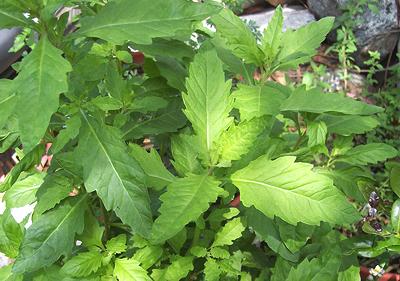Epazote
 [Stinkweed, Skunkweed, Wormseed, Jesuit's Tea, Mexican Tea, Paico,
Herba Sancti Mariæ (Spanish): Dysphania ambrosioides syn
Chenopodium ambrosioides]
[Stinkweed, Skunkweed, Wormseed, Jesuit's Tea, Mexican Tea, Paico,
Herba Sancti Mariæ (Spanish): Dysphania ambrosioides syn
Chenopodium ambrosioides]
A common weed in southern Mexico, Central and South America, Epazote is
now grown in the warmer parts of North America and sometimes becomes an
invasive weed here. Its main culinary use is for flavoring black beans
and to a lesser extent other recipes from southern Mexico and Central
America. It is reputed to prevent flatulence from eating beans and to
relieve a number of medical conditions. An oil extracted from the seeds
kills intestinal worms and is also an antispasmodic and abortifacient.
The smell of epazote is quite strong but extremely difficult to
describe. Leading spice expert Gernot Katzer says it smells to him like
epazote.
More on Amaranths.
Buying:
If you live in an area where there is a large
population from southern Mexico and Central America, you'll find this herb
available erratically in markets that cater to them. Otherwise, you need
to grow it yourself. If you live in a reasonably warm climate, that's easy
- it grows enthusiastically and you may end up fighting it as a common
weed. It is quite seasonable so will not always be available.
Storing:
If fresh, it will keep loosely bagged in the
refrigerator for maybe 5 days. Dried epazote is considered "satisfactory"
if it is fairly fresh.
Subst:
There isn't anything really close. My recommendation
is half and half fresh Oregano and fresh Mint.
Health & Nutrition:
In large quantities
epazote is toxic (as are many medicinal plants), but in the amounts used
as a flavoring herb no adverse effects have been reported. There have been
reports of death from overdoses of essential oil of Epazote
ch_epazoz 090527 - www.clovegarden.com
©Andrew Grygus - agryg@clovegarden.com - Photos on this
page not otherwise credited are © cg1 -
Linking to and non-commercial use of this page permitted
 [Stinkweed, Skunkweed, Wormseed, Jesuit's Tea, Mexican Tea, Paico,
Herba Sancti Mariæ (Spanish): Dysphania ambrosioides syn
Chenopodium ambrosioides]
[Stinkweed, Skunkweed, Wormseed, Jesuit's Tea, Mexican Tea, Paico,
Herba Sancti Mariæ (Spanish): Dysphania ambrosioides syn
Chenopodium ambrosioides]